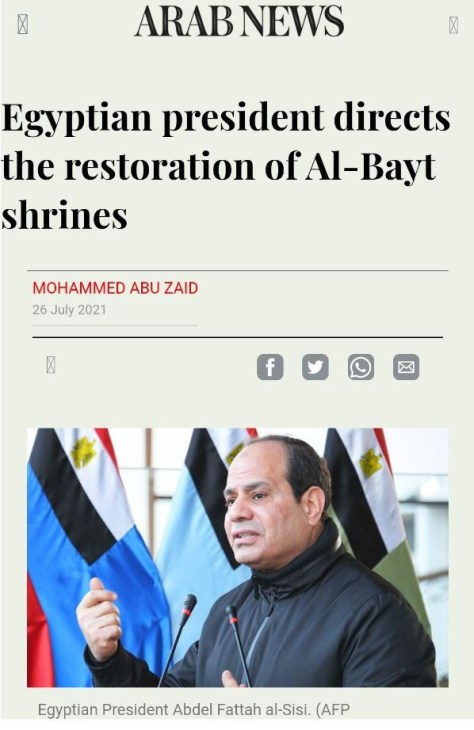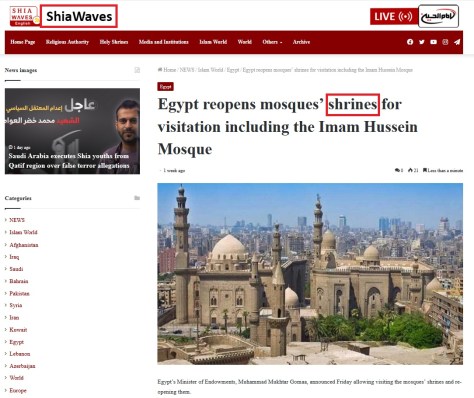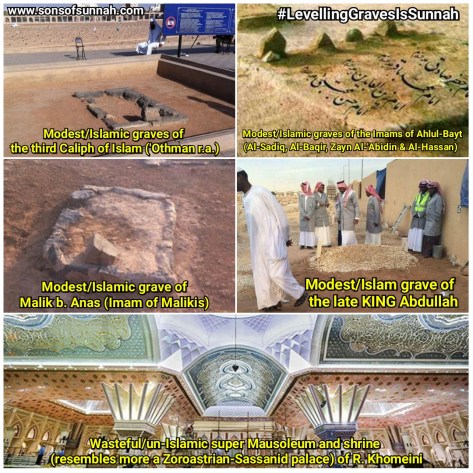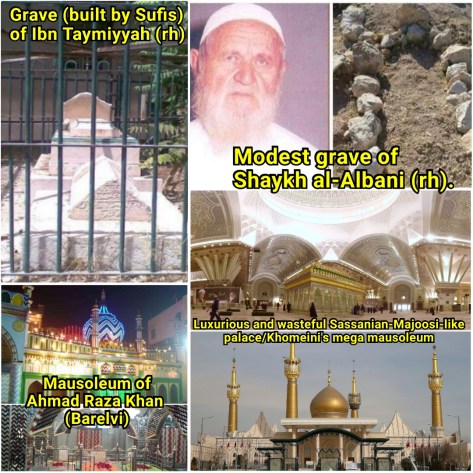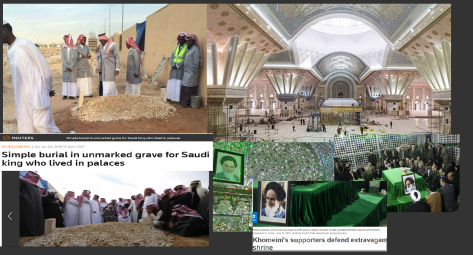 In today’s context, the Ummah finds itself deeply engaged with a range of matters, sometimes leading to challenges in staying updated on all the news. This situation is readily exploited by malicious individuals to further their own interests and propagate their mischief and malevolence in the Muslim lands, often under the pretense of ‘spirituality’ and ‘devotion to the Awliya/Ahl al-Bayt’.
In today’s context, the Ummah finds itself deeply engaged with a range of matters, sometimes leading to challenges in staying updated on all the news. This situation is readily exploited by malicious individuals to further their own interests and propagate their mischief and malevolence in the Muslim lands, often under the pretense of ‘spirituality’ and ‘devotion to the Awliya/Ahl al-Bayt’.
An aspect that has garnered minimal attention, even within the Arab world, is Egypt’s proactive efforts to bolster ‘religious tourism,’ particularly centered around tomb and shrine visits. This initiative is actively supported by Sufi establishment in Egypt.
In this article, we will uncover the pagan essence of the fabricated graves that the Sufis hold in reverence. Driven by their lack of knowledge and a strong inclination towards tomb and shrine veneration, these individuals have inadvertently become tools of the Rafidah and Batiniyyah heretical factions.
The Link Between Shia and Sufi Grave Worship In Egypt
Sufis within Egypt have established a multitude of shrines associated with the Ahl al-Bayt, wherein the deplorable acts of polytheistic tomb and shrine veneration are as widespread as the infamous bastions of such practices like Qom, Najaf, and Karbala. Not surprisingly, the Iranian Rafidi Khomeinist regime has consistently provided robust backing for tomb pilgrimages to Egypt.
The close affinity between Sufism and Shiism led Ibn Khaldun to say that the later Sufis mixed with the Ismaili Rafidah Shia (‘Fatimids’), who were the early proponents of practices like celebrating the Prophet’s () Mawlid (birth) and excessively venerating saints tombs and shrines. As a result, both groups mutually influenced and learned from each other.
“Indeed, these later Sufi Mutakallims, delving into matters of revelation and the metaphysical beyond perception, went deeply into it… Their predecessors were in contact with the late Ismaili Rafidah Shia…”
Tomb & Mosque of Sayyidah Nafisa – Cairo
The Sayyidah (Lady) Nafisa Mosque in Cairo stands upon the purported tomb of Sayyidah Nafisa. She held the esteemed position of being the great-granddaughter of the Prophet Muhammad (), as the daughter of al-Hasan al-Anwar, who was the son of Zayd ibn ibn Hasan ibn Ali ibn Abi Talib. The bogus shrine ascribed to her has become a hub for Sufi superstitions and the veneration of graves in Egypt.
The Nafisah Mosque and Shrine are situated on Ahl al-Bayt Street in Cairo, Egypt, where a number of mausoleums associated with the Ahl al-Bayt are found along the route. Following the Imam Ali Zayn al-Abidin Shrine, the Nafisah Mosque stands as the second prominent site on the street. The street commences with the shrine of Imam Zaynul-Abidin and concludes with the Sayyidah Zaynab mosque while passing by the mausoleums of Sayyidah Nafisah, Sayyidah Sakinah bint Husayn, Sayyidah Ruqqiyah bint Ali bin Abu Talib, Sayyid Muhammad ibn Jafar al-Sadiq, and Sayyidah Atikah.
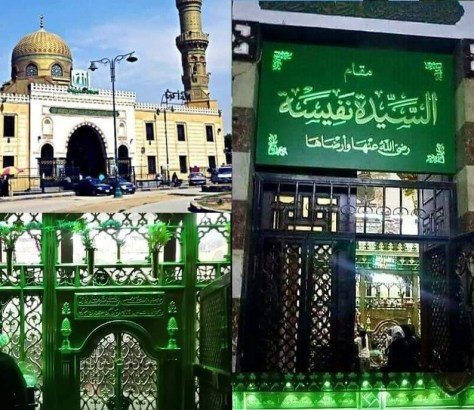
Annually, during the birthdays of Sufi saints and the Ahl al-Bayt, Sufi communities in Egypt convene in ceremonies. On the commemorative days of Nafisah and Zaynab’s births, Sufis gather to receive blessings from their entombed saints and conduct tawaf encircling the shrines. This practice has evolved into a tradition, with even brides participating in tawaf to bestow blessings upon their marriages.
Al-Dhahabi in his ‘Al-Siyar’ says in his entry about Nafisah:
[السيدة نفيسة]ابنة أمير المؤمنين الحسن بن زيد بن السيد سبط النبي – صلى الله عليه وسلم – الحسن بن علي رضي الله عنهما، العلوية الحسنية صاحبة المشهد الكبير المعمول بين مصر والقاهرة (١٠/ ١٠٦).لجهلة المصريين فيها اعتقاد يتجاوز الوصف ولا يجوز مما فيه من الشرك، ويسجدون لها، ويلتمسون منها المغفرة، وكان ذلك من دسائس دعاة العُبيدية
“Lady Nafisa, the daughter of the Commander of the Faithful, Imam Al-Hasan ibn Zayd, who is from the lineage of the Prophet () through Al-Hasan ibn Ali (may Allah be pleased with them both). She is from the Alid-Hasanid lineage. She is associated with the grand mausoleum constructed between Egypt and Cairo (10/106). Due to the ignorance of the Egyptians about her, there is a belief attributed to her that goes beyond description and involves unacceptable acts of polytheism. People prostrate to her and seek forgiveness from her. All of these actions stem from the schemes devised by the supporters of the Ubaydiyyah (followers of the Ismaili Rafidi Shia ‘Fatimids’).” (Siyar A’lam al-Nubala by Al-Dhahabi)
The close affinity between Sufism and Shiism led Ibn Khaldun to say that the later Sufis mixed with the Ismaili Rafidi Shia (who were the first to introduce Mawlid of the Prophet and saints), and each group learned from the other.


 The individual who initially constructed Nafisah’s tomb was a deviant Abbasid ruler named Ubaydullah ibn al-Suri, who served as the governour of Egypt in the midst of the Abbasid era. Subsequently, the shrine underwent a reconstruction phase during the ‘Fatimid’ (Ismaili Rafidi Shia) era, during which the addition of a dome also took place.
The individual who initially constructed Nafisah’s tomb was a deviant Abbasid ruler named Ubaydullah ibn al-Suri, who served as the governour of Egypt in the midst of the Abbasid era. Subsequently, the shrine underwent a reconstruction phase during the ‘Fatimid’ (Ismaili Rafidi Shia) era, during which the addition of a dome also took place.
The ‘Fatimids’ maintained a tradition of renovating the mausoleum and shrine, a custom that was also upheld by the Ottomans. The Ottomans constructed the shrine in a design akin to the present-day structure.
The former silver shrine has now been replaced with an even more opulent Rafidi-like golden enclosure/shrine. This was crafted by a Sufi from India. In order to mark the burial site known as Ra’s al-Hussain (Arabic: رَأس ٱلحُسَين) or Mashhad Ra’s al-Hussain, Taher Saifuddin oversaw the construction of a shrine in Mumbai, which was subsequently placed in the mosque in 1965, shortly before his passing. The inauguration of this shrine was carried out by his son, Mohammed Burhanuddin, following tradition.
The shrine was originally meant for Abbas Mosque, in Karbala, Iraq but could not be installed there. The location and the shrine had previously been measured precisely, but it simply didn’t fit. Taher Saifuddin, the maker of the shrine then claimed to have received ‘divine guidance’ by way of intuition that out of loyalty, he could not allow Ra’s (the head) Imam Hussain to be without a shrine. As a consequence, Abbas’ shrine was flown to Cairo and installed at Ra’s al-Hussain at the al-Hussain mosque, instead.

 In August 2021, Egyptian President Abdel Fattah al-Sisi issued instructions to the relevant authorities for the restoration and renovation of the shrines allegedly belonging to Ahl al-Bayt across Egypt. This effort is particularly directed towards the tombs of Nafisa, Zaynab, and Husayn. Furthermore, improvements have been made to the roads, squares, and nearby facilities to facilitate easier and smoother tomb and shrine veneration.
In August 2021, Egyptian President Abdel Fattah al-Sisi issued instructions to the relevant authorities for the restoration and renovation of the shrines allegedly belonging to Ahl al-Bayt across Egypt. This effort is particularly directed towards the tombs of Nafisa, Zaynab, and Husayn. Furthermore, improvements have been made to the roads, squares, and nearby facilities to facilitate easier and smoother tomb and shrine veneration.
The ‘Syeds/Sayeds/Sharifs’ and other dubious claimants of Hashimite lineage are all celebrating:
“The head of the Al-Ashraf Syndicate (Al-Ashraf are those who belong to the lineage of Muhammad), Mahmoud al-Sharif, told Al-Monitor, “Developing the roads, squares and facilities surrounding the Ahl al-Bayt mosques will make them more attractive to visitors and easier to reach, thus allowing visitors from all over the world to access these shrines once again.”
The Sufis find contentment as the shrines serve as their main source of sustenance.
Meanwhile, Abdel Hadi al-Qasabi, the president of the Supreme Council of Sufi Orders, said in a July 26 interview on Mehwar TV, ‘The interest in Ahl al-Bayt shrines is a revival of the values of love, sincerity, tolerance and acceptance of others, which is what we need at this time to preserve the successes of the Egyptian state in all fields during the recent period.”
No need to be concerned! Both these spiritual leaders and secular authorities have our welfare, well-being, and spirituality at heart.
Abdel Rahim Rihan, director general of research, archaeological studies and scientific publishing in South Sinai at the Tourism Ministry, told Al-Monitor, “The political leadership’s sponsorship of shrines and [Sisi’s] directives to restore and renovate them, as well as the roads leading to them, boost these shrines’ value and contribute to revitalizing religious tourism in Egypt.”
He said, “The state’s interest in developing these attractions and facilitating access to them will make Egypt a destination for religious tourism for Muslim and Christian pilgrims alike from all over the world.”
- Why not invoke Jesus, Mary, Husayn, and Nafisah collectively? After all, Sufi Muftis have endorsed this as a valid aspect of Islamic tradition.
Rihan said, “Restoring shrines helps to complete the religious tourism system, which also includes the Holy Family Trail that blesses the land of Egypt from Rafah in Sinai to the Muharraq Monastery in Assiut governorate.”
He pointed out that the two routes can be linked into one path to include visits to the holy family’s sites in Cairo, such as the Tree of the Virgin Mary in al-Matariyyah, the Maadi Church, the churches of ancient Egypt and the shrines of Ahl al-Bayt.
More and more shrines…
Rihan said, “The most famous shrines in Egypt [of Muhammad’s descendants] are located on al-Ashraf Street or what is known as Ahl al-Bayt Road in central Cairo. This street includes the tombs of Zain al-Abidin, Sayyida Nafisa, Sakinah bint Husayn, Sayyida Zeinab, Ibn Sirin and Ruqayah bint Ali, in addition to other shrines in different locations, such as the tomb of Fatma al-Nabawiyya in the al-Darb al-Ahmar district.”
Predictably, the principal foe of Ahl al-Sunnah is unabashedly backing the Sufi shenanigans in Egypt.
The Egyptian authorities were commended for their dedication to wasting finances and resources on spurious tombs and shrines falsely linked to the Ahl al-Bayt. This acclaim came from none other than Moqtada al-Sadr, the leader of Iranian-backed Shia militias and death squads notorious for his atrocities against Iraqi Sunnis.
Moqtada al-Sadr took to Twitter to endorse the shrine-renovation initiatives in Egypt. He also shared his aspirations that his counterparts in Saudi Arabia would similarly consider restoring idolatrous Sufi-Rafidi shrines in Al-Baqi cemetery in Madinah. According to Al-Sadr, this action would serve to unite the Muslim community. His tweet concluded with the hashtag #Moderation_Is_Truth.
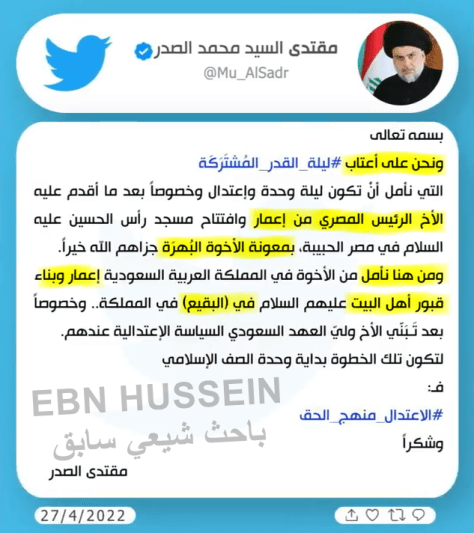
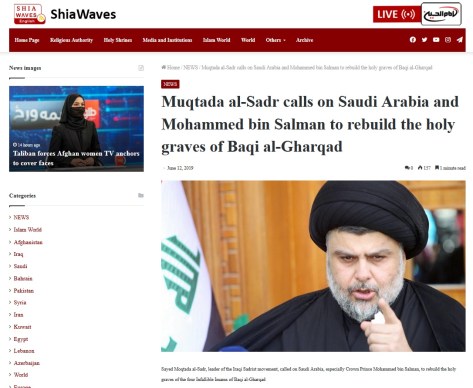
In June 2021, a new shrine was inaugurated above the tomb during the visit of the leader of the Dawoodi Bohras (descendants of the ‘Fatimids’ within the Ismaili Rafidi Shia branch), with the presence of Sufi Azhari scholars.

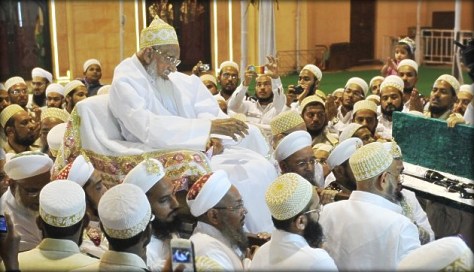
President Abdel-Fattah El-Sisi inaugurated on Wednesday El-Hussein Mosque after extensive renovations in the presence of Sultan of the Indian Bohra community Mufaddal Saifuddin.
The President performed mosque greeting prayer and then recited Al-Fatiha, the first surah of the Holy Quran in front of the shrine of Imam El-Hussein.
The renovations were implemented as per El-Sisi’s directives to develop the shrines of ‘Ahl El-Bayt’ (‘The family of the Islamic prophet Muhammad’) across Egypt.
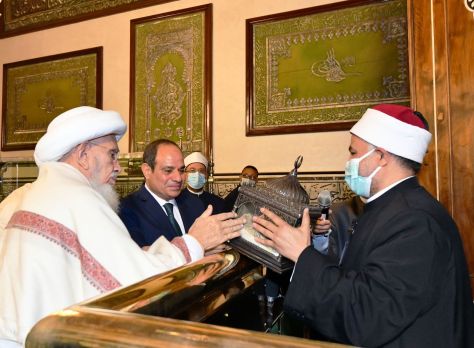
Yes, the financially disadvantaged Egypt expended substantial amounts of money on extravagant Rafidi-Sufi tombs and shrines.
The project kicked off in mid-March. The mosque was closed and the renovations were launched based on a protocol signed in December with the Ministry of Awqaf, syndicate of Al Ashraf, the Sufi Association, and Mawadda association for the development and embellishment of the Imam Hussein Mosque. According to the protocol, the Masajid Development Foundation pledged to fund the project with 150 million Egyptian pounds.
Because, you see… the formerly modest and simple graves of the Ahl al-Bayt (who led lives of simplicity and favoured unadorned graves) evidently need to be transformed into extravagantly opulent structures (similar to the grandeur of the ‘Imam of the Oppressed’ in Tehran). This transformation seems aimed at both intimidating and astonishing the unsuspecting crowds, fostering a psychological connection to the tombs and shrines of the presumed buried figures (if indeed anyone is interred there at all).
As expected, secular authorities across the Muslim world tend to exhibit a strong inclination toward and endorsement of the practice of grave and tomb veneration, the real and actual opiate of the people.














